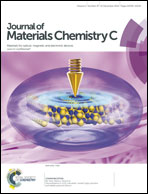New dithienyl-diketopyrrolopyrrole-based conjugated molecules entailing electron withdrawing moieties for organic ambipolar semiconductors and photovoltaic materials†
Abstract
In this paper we report two DPP-based conjugated molecules DPPBT and DPPTT in which the respective electron withdrawing moieties 2,1,3-benzothiadiazole and thiazolo[5,4-d]thiazole are flanked by two DPP moieties. For comparison, DPPBZ containing 1,4-diethynylbenzene and two DPP moieties were synthesized. HOMO/LUMO energies of DPPBT, DPPTT and DPPBZ were estimated on the basis of cyclic voltammetric data. Owing to the fact that LUMO energies of DPPBT and DPPTT were lowered to ca. −3.5 eV, thin films of both DPPBT and DPPTT exhibit ambipolar semiconducting properties under N2 atmosphere with hole and electron mobilities up to 0.25 cm2 V−1 s−1 and 0.09 cm2 V−1 s−1, respectively. In comparison, thin film of DPPBZ just shows p-type semiconducting property. Notably, ambipolar semiconductors with relatively high carrier mobility are rarely reported for DPP-containing small conjugated molecules. Alternatively, both DPPBT and DPPTT can function as electron donors for photovoltaic materials. Thin films of DPPTT:PC71BM and DPPBT:PC71BM at a weight ratio of 1 : 1 exhibit PCEs of 4.18% and 2.44%, respectively, with VOC higher than 0.95 V.


 Please wait while we load your content...
Please wait while we load your content...